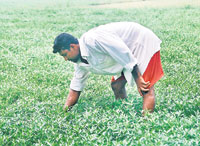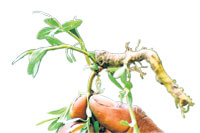
Please don’t eat mallung leaf lookalike
A wild plant that looks much like the edible mukunuwenna has been found growing wild on farms in the Madampe area of the Puttalam district. The plant, popularly known as “alligator weed”, has been detected growing on land dedicated to mukunuwenna cultivation. Cause for concern is the fact that the plant is believed to be harmful to animals and possibly humans. Livestock that have come into contact with the alligator weed sometimes develop a skin infection that manifests itself in a heightened sensitivity to sunlight.
The invasive aquatic weed is scientifically referred to as Alternanthera philoxeroides, while mukunuwenna bears the name Alternanthera sessilis. According to K. Piyasena, deputy director, Department of Agriculture (Plants Conservation), the weed absorbs metal substances found in the soil, such as copper, and this can be hazardous to animals and humans who consume the plant. “It grows like a blanket on water surfaces and can provide a habitat for mosquitoes,” Mr. Piyasena said. “Also, by preventing light penetration and water oxygenation, the weed can kill off fish and other water creatures.” A native of South America, the wild plant was first detected in Sri Lanka in 1999, in the western and southern provinces. It has been noted that the plant tends to grow alongside the indigenous mukunuwenna plant, in areas where the soil is soft and water is in plenty. The plant has shiny leaves of a dark green hue, with occasional tiny flowers. The shine on its leaves is one way to identify the weed; the mukunuwenna leaf has no shine. Local farmers appear to be encouraging the growth and spread of the alligator weed, although its cultivation has been banned. Research officers at the Gannoruwa research school in Peradeniya have visited areas where the weed grows and taken samples for further analysis. Meanwhile, farmers say the weed may have come along with seed plants they had purchased from established plant sellers. |
|
||||||
|| Front
Page | News | Editorial | Columns | Sports | Plus | Financial
Times | International | Mirror | TV
Times | Funday
Times || |
| |
Reproduction of articles permitted when used without any alterations to contents and a link to the source page.
|
© Copyright
2008 | Wijeya
Newspapers Ltd.Colombo. Sri Lanka. All Rights Reserved. |

